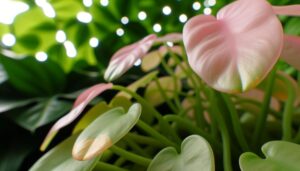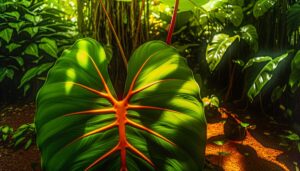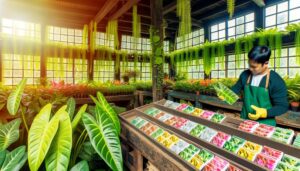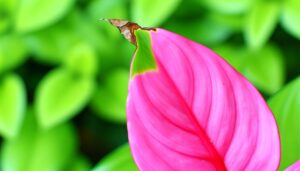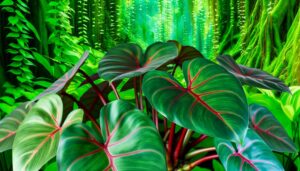What Temperature Is Best for a Philodendron Brasil?
Philodendron Brasil thrives in temperatures between 65°F and 80°F (18°C to 27°C). Best daytime temperatures range from 75°F to 85°F (24°C to 29°C), while nighttime temperatures should be maintained between 60°F and 70°F (16°C to 21°C).
Deviating below 65°F can slow growth and induce chlorosis, while exceeding 80°F accelerates transpiration, leading to water stress. Seasonal variations, ideally, shift from 65°F to 75°F in cooler months.
Maintaining consistent temperatures within the best range is essential to guarantee robust growth and vibrant foliage. For a thorough understanding of seasonal adjustments and transpiration impacts, explore further insights.
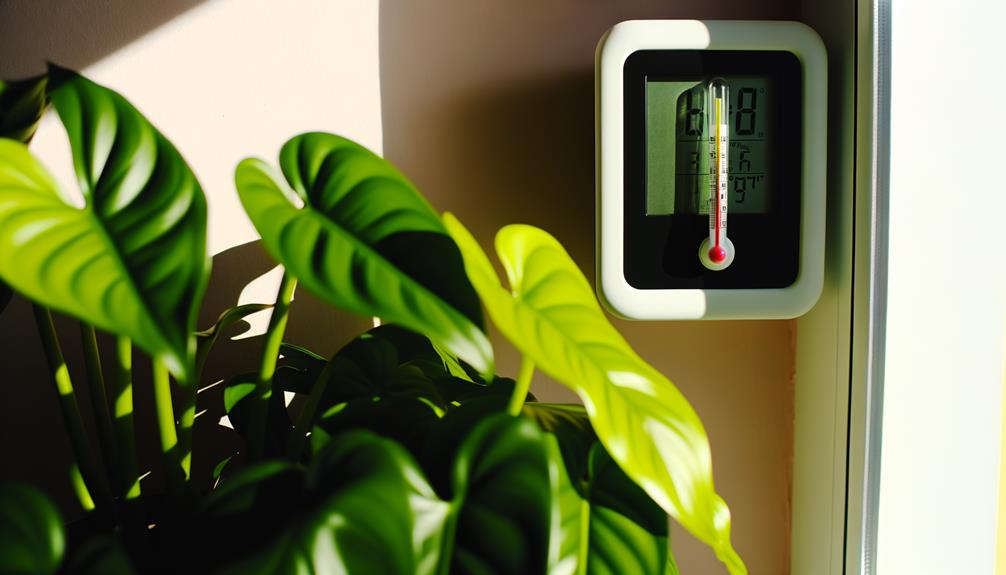
Key Takeaways
- Philodendron Brasil thrives in temperatures between 65°F (18°C) and 80°F (27°C).
- Ideal daytime temperatures are 24°C to 29°C, while nighttime should be 60°F to 70°F.
- Avoid temperatures below 60°F to prevent cold damage and slowed growth.
- Temperatures above 80°F can increase transpiration, causing water stress.
- Consistent temperatures within the 65°F to 80°F range promote optimal growth and foliage.
Optimal Temperature Range
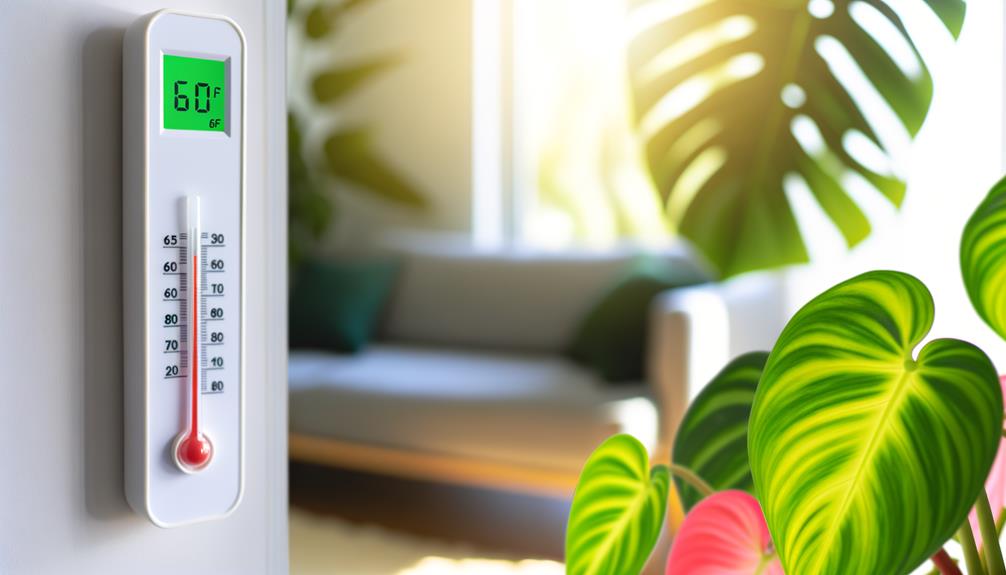
The best temperature range for Philodendron Brasil is between 65°F and 80°F (18°C to 27°C), where the plant exhibits robust growth and minimal stress. Within this range, metabolic processes such as photosynthesis and respiration operate at their peak.
Empirical observations indicate that deviations below 65°F (18°C) can lead to reduced cellular activity, manifesting in slower growth and potential chlorosis. Conversely, temperatures exceeding 80°F (27°C) can accelerate transpiration rates, risking dehydration.
Maintaining consistent temperatures within this specified range is essential for the physiological well-being of Philodendron Brasil. Any prolonged exposure outside this range necessitates environmental adjustments, like the use of humidifiers or strategic placement, to mitigate adverse impacts and sustain the plant's health and aesthetic value.
Daytime Temperatures
Daytime temperatures play a vital role in the physiological processes of Philodendron Brasil.
The ideal growth range for this species is between 24°C and 29°C, ensuring best photosynthetic activity.
It is important to monitor temperature fluctuations, as significant deviations can impede growth and lead to stress symptoms.
Ideal Growth Range
Ideal growth for Philodendron Brasil occurs within a temperature range of 65 to 80 degrees Fahrenheit during the daytime. This temperature band supports peak physiological processes, including photosynthesis, respiration, and nutrient assimilation.
At 65 degrees Fahrenheit, the plant's metabolic activities remain effective, while temperatures approaching 80 degrees Fahrenheit maximize enzymatic reactions crucial for growth. Observations indicate that within this thermal spectrum, the Philodendron Brasil exhibits improved leaf coloration, strong stem development, and increased foliage density.
Deviations from this range may hinder growth rates and impact overall plant health. Maintaining consistent daytime temperatures within these parameters safeguards the plant's cellular structure and function, promoting vigorous and sustained vegetative growth.
Temperature Fluctuations
Fluctuations in daytime temperatures can greatly influence the physiological stability and growth patterns of Philodendron Brasil. Peak growth occurs within a narrow thermal range of 70-80°F (21-27°C). Deviations beyond this range, even temporarily, can induce thermal stress, impacting photosynthetic efficiency and stomatal conductance.
Studies indicate that sudden drops below 60°F (15°C) or spikes above 90°F (32°C) can disrupt cellular metabolic processes, leading to reduced chlorophyll synthesis and compromised vascular function. Consistent monitoring of ambient temperature is essential, as prolonged exposure to non-ideal temperatures can result in stunted growth and foliar chlorosis.
Implementing temperature regulation strategies, such as controlled environment agriculture (CEA) systems, guarantees stable conditions conducive to peak physiological performance and robust growth.
Nighttime Temperatures
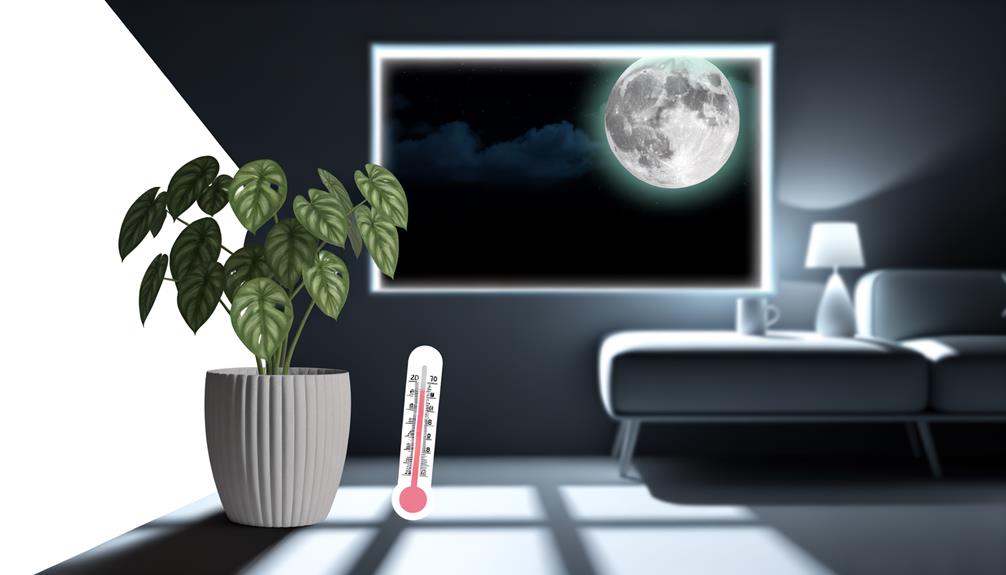
Philodendron Brasil thrives best when nighttime temperatures are maintained within the range of 60-70°F (15-21°C). This specific temperature range ensures peak metabolic processes and reduces stress on the plant's physiological systems.
Observations indicate that temperatures below 60°F (15°C) can slow down growth and potentially lead to cold damage, manifesting as leaf discoloration or wilting. Conversely, temperatures exceeding 70°F (21°C) may speed up respiration rates, leading to excessive water loss and nutrient deficiencies.
It is important to monitor and regulate nighttime temperatures to provide an ideal environment conducive to healthy growth. Consistency in these parameters supports the plant's natural circadian rhythms, promoting strong development and vibrant foliage.
Seasonal Variations
Understanding how Philodendron Brasil responds to seasonal variations is pivotal for optimizing its growth conditions throughout the year. During the spring and summer months, this tropical species thrives in temperatures ranging from 24°C to 29°C, benefiting from increased photoperiods and higher humidity levels, typically between 60-80%.
In contrast, autumn and winter necessitate a more controlled environment, where temperatures should be maintained between 18°C and 24°C to prevent metabolic slowdown and leaf chlorosis. Indoor cultivation is advised during colder months, ensuring stable thermal conditions and mitigating the risks of draughts.
Monitoring and adjusting environmental parameters in response to these seasonal shifts is essential for sustaining the plant's physiological health and promoting robust foliage development.
Temperature Extremes
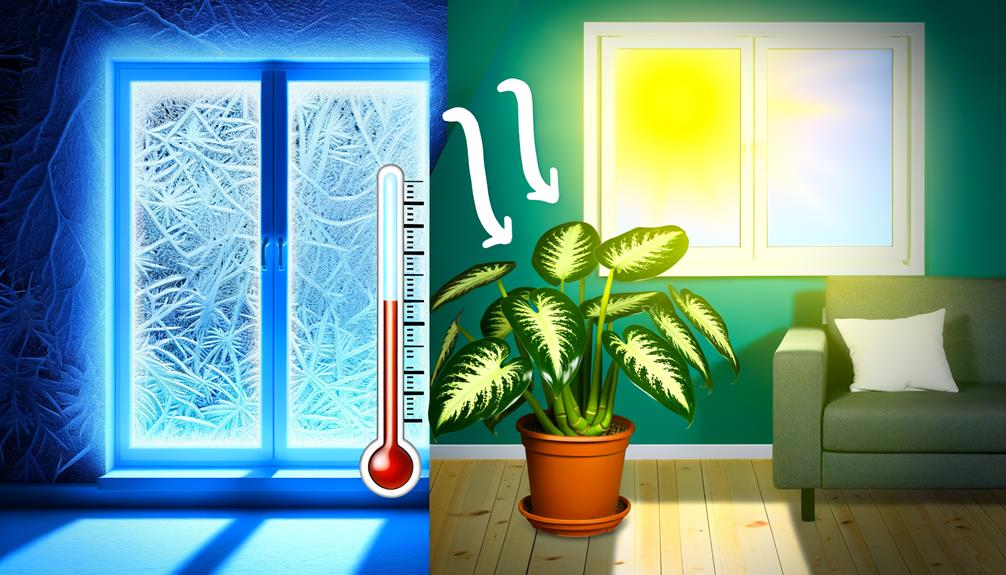
Extreme temperature deviations, particularly those exceeding 30°C or falling below 15°C, can hinder the physiological processes of Philodendron Brasil to a great extent, leading to symptoms such as leaf scorch or cold-induced chlorosis. Maintaining ideal temperatures is essential for this plant to thrive.
Several adverse effects of extreme temperatures include:
- Enzyme Denaturation: High temperatures can denature essential enzymes, disrupting metabolic pathways.
- Reduced Photosynthesis: Excessive heat can impair chlorophyll function, reducing photosynthetic efficiency.
- Water Stress: High temperatures increase transpiration rates, leading to potential water deficits.
- Cold Damage: Prolonged exposure to low temperatures can cause cellular damage, compromising plant vitality.
Understanding these temperature-related stressors is crucial for ensuring the health and longevity of Philodendron Brasil.
Effects of Cold
Prolonged exposure to temperatures below 15°C can induce cold stress in Philodendron Brasil, manifesting as chlorosis, leaf curling, and inhibited growth.
Chlorosis, or the yellowing of leaves, results from impaired chlorophyll synthesis under suboptimal thermal conditions.
Leaf curling, a physiological response to minimize water loss, signifies cellular dehydration.
Inhibited growth is observed due to the disruption of metabolic processes, particularly enzymatic activities that are temperature-dependent.
Additionally, prolonged cold can lead to root damage, further impairing nutrient uptake and water absorption.
A temperature gradient below 10°C notably exacerbates these symptoms, potentially leading to necrosis and plant death.
Ensuring stable temperatures within the ideal range is critical for maintaining the physiological and morphological health of Philodendron Brasil.
Effects of Heat
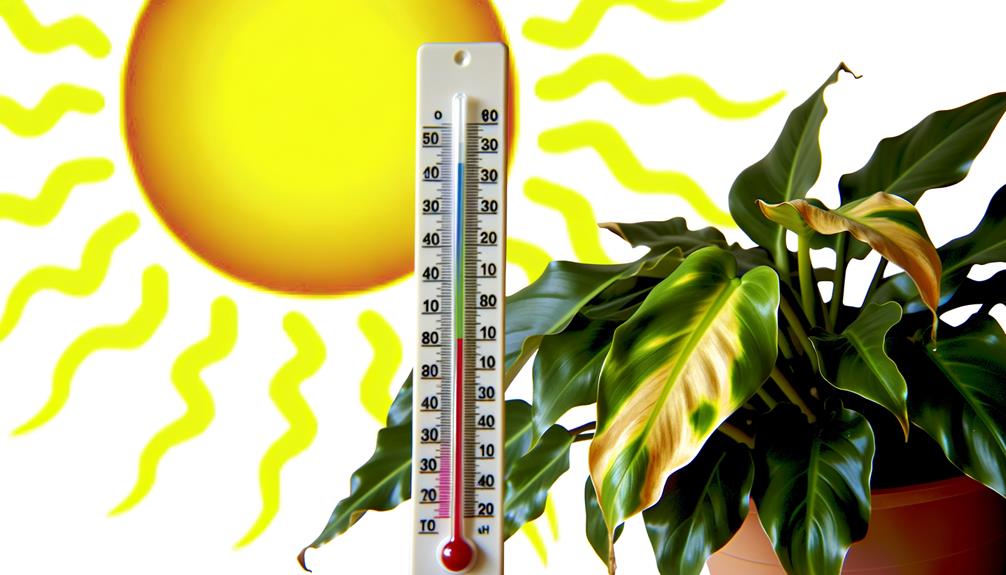
Elevated temperatures above 30°C can negatively impact Philodendron Brasil, leading to increased transpiration rates and subsequent water stress. This thermal stress can disrupt physiological processes and degrade plant health.
Observations indicate that prolonged exposure to high temperatures can result in:
- Leaf Scorching: Margins of leaves turn brown due to cellular damage.
- Reduced Growth: High temperatures inhibit photosynthesis, leading to stunted growth.
- Wilting: Elevated transpiration rates cause rapid water loss, leading to wilting.
- Nutrient Deficiency: Heat stress can impair nutrient uptake, resulting in yellowing leaves.
These effects underscore the importance of maintaining an ideal temperature range to support the vitality of Philodendron Brasil. Adequate monitoring and environmental control are crucial to mitigate these adverse impacts.
Ideal Humidity Levels
Maintaining an ideal humidity level between 60% and 80% is important for the Philodendron Brasil to support its physiological functions and overall health. Elevated humidity facilitates the most efficient transpiration rates, ensuring effective nutrient uptake and gas exchange.
Lower humidity levels, by contrast, can lead to desiccation of leaf margins and decreased stomatal function, impairing photosynthetic efficacy. Observations indicate that ambient humidity below 60% often results in leaf curling and browning, symptoms of stress and suboptimal hydration.
Conversely, environments exceeding 80% humidity may promote fungal pathogens, necessitating vigilant monitoring. Employing hygrometers for precise humidity measurement and utilizing humidifiers or pebble trays can help maintain these conditions.
Regular misting also aids in sustaining the necessary microclimate for this tropical species.
Temperature Monitoring Tips

Accurate temperature monitoring is essential for enhancing the growth conditions of Philodendron Brasil, ensuring temperatures consistently range between 65°F and 80°F.
To maintain this optimal range, consider the following strategies:
- Use Digital Thermometers: Place precise digital thermometers at different locations around the plant to measure ambient temperature accurately.
- Regular Monitoring: Record temperature measurements at various times of the day to identify any fluctuations that may impact plant health.
- Avoid Drafts: Position the plant away from air vents, windows, and doors to prevent exposure to sudden temperature changes.
- Thermostatic Control: Employ thermostatic devices to regulate room temperature within the desired range, ensuring a stable environment for the Philodendron Brasil.
Correcting Temperature Issues
To effectively address temperature discrepancies that may hinder the growth of Philodendron Brasil, it is important to identify the specific deviations from the ideal range of 65°F to 80°F and implement targeted corrective measures. Assess the ambient temperature using a reliable thermometer. Should temperatures exceed or fall below this range, employ appropriate strategies to normalize conditions.
| Deviation | Observation | Corrective Measure |
|---|---|---|
| < 65°F | Leaf Yellowing, Stunted Growth | Use Heating Pads, Relocate to Warmer Area |
| > 80°F | Leaf Wilting, Browning Edges | Increase Ventilation, Use Fans |
| Fluctuations | Inconsistent Growth | Stabilize Environment, Use Insulated Curtains |
| Draft Exposure | Leaf Curling | Shield from Drafts, Use Weather Stripping |
| Low Humidity | Dry Leaf Tips | Use Humidifiers, Mist Regularly |
Additional Care Tips
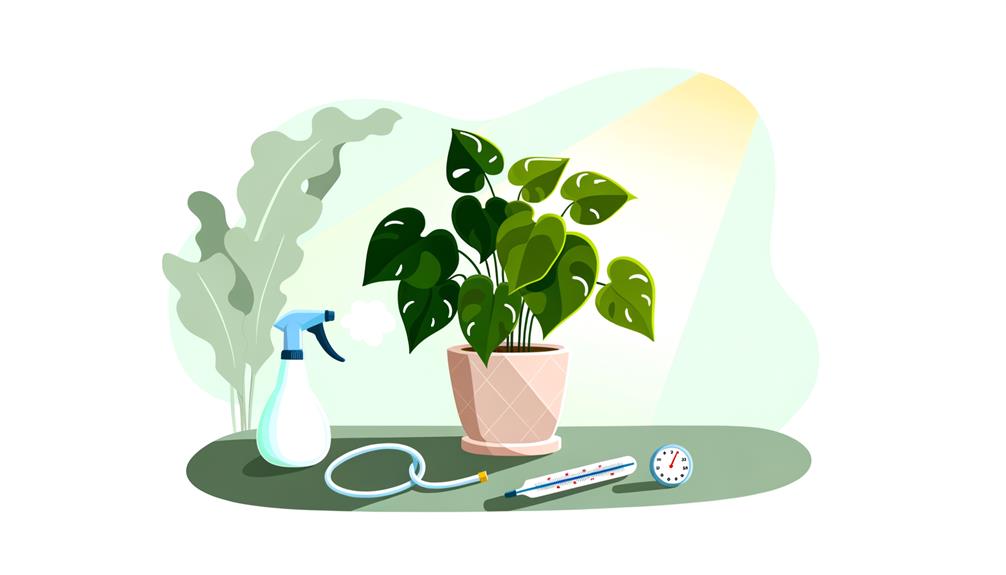
To guarantee best growth for Philodendron Brasil, attention to its watering and humidity needs, soil composition, and fertilization regimen is essential.
Maintaining a balanced approach to pruning and propagation can enhance plant health and aesthetics.
Detailed observations of these factors contribute greatly to the overall health of this species.
Watering and Humidity Needs
Maintaining best watering and humidity levels is essential for the health and growth of a Philodendron Brasil, as these factors greatly influence its physiological processes. The species thrives in consistently moist soil, yet it is important to avoid waterlogged conditions that may lead to root rot.
Optimal humidity levels range from 60% to 80%, conducive to its tropical origins. To achieve these conditions, consider the following recommendations:
- Watering Frequency: Water when the top 2-3 cm of soil is dry to touch.
- Humidity Maintenance: Use a humidifier or place the plant on a humidity tray.
- Water Quality: Preferably use distilled or rainwater to avoid mineral buildup.
- Environmental Monitoring: Utilize a hygrometer to precisely measure ambient humidity.
These practices promote robust growth and health.
Soil and Fertilization
Securing ideal soil composition and appropriate fertilization regimens are equally vital for the Philodendron Brasil's vigorous development and overall physiological health. This species thrives in a well-draining potting mix, ideally comprising 40% peat moss, 30% perlite, and 30% pine bark. Such a medium secures adequate aeration and moisture retention, preventing root rot.
Fertilization should be performed bi-monthly during the growing season (spring and summer) using a balanced, water-soluble fertilizer with an N-P-K ratio of 20-20-20, diluted to half strength. Over-fertilization can lead to nutrient burn, characterized by browning leaf edges. Organic options, such as worm castings, can be incorporated to enhance soil fertility and microbial activity, hence fostering a robust root system and vibrant foliage.
Pruning and Propagation
Effective pruning of the Philodendron Brasil involves the strategic removal of yellowing or damaged leaves to promote healthier growth and prevent disease spread. Pruning should be conducted with sterilized scissors to reduce the risk of pathogen transmission.
Best propagation is achieved via stem cuttings, making sure nodes are submerged in water or a well-draining soil medium to encourage root development.
To maximize success in propagation, consider the following guidelines:
- Timing: Propagate during the plant's active growth phase (spring to early summer).
- Cutting Length: Select stem cuttings approximately 10-15 cm in length.
- Node Inclusion: Guarantee each cutting has at least one node, as this is where roots will form.
- Environment: Maintain a humid environment and indirect light for best root formation.
These practices enhance plant health and proliferation potential.
Conclusion
To sum up, maintaining the best temperature range for Philodendron Brasil is essential for its healthy growth. Daytime temperatures should ideally range between 70-80°F (21-27°C), while nighttime temperatures should not drop below 60°F (16°C).
Seasonal variations must be managed to prevent exposure to temperature extremes. Some may argue that philodendrons are resilient, yet consistent temperature control, paired with ideal humidity levels, is vital to avoid stress and promote strong development.
Accurate monitoring and timely interventions ensure sustained plant vitality.


